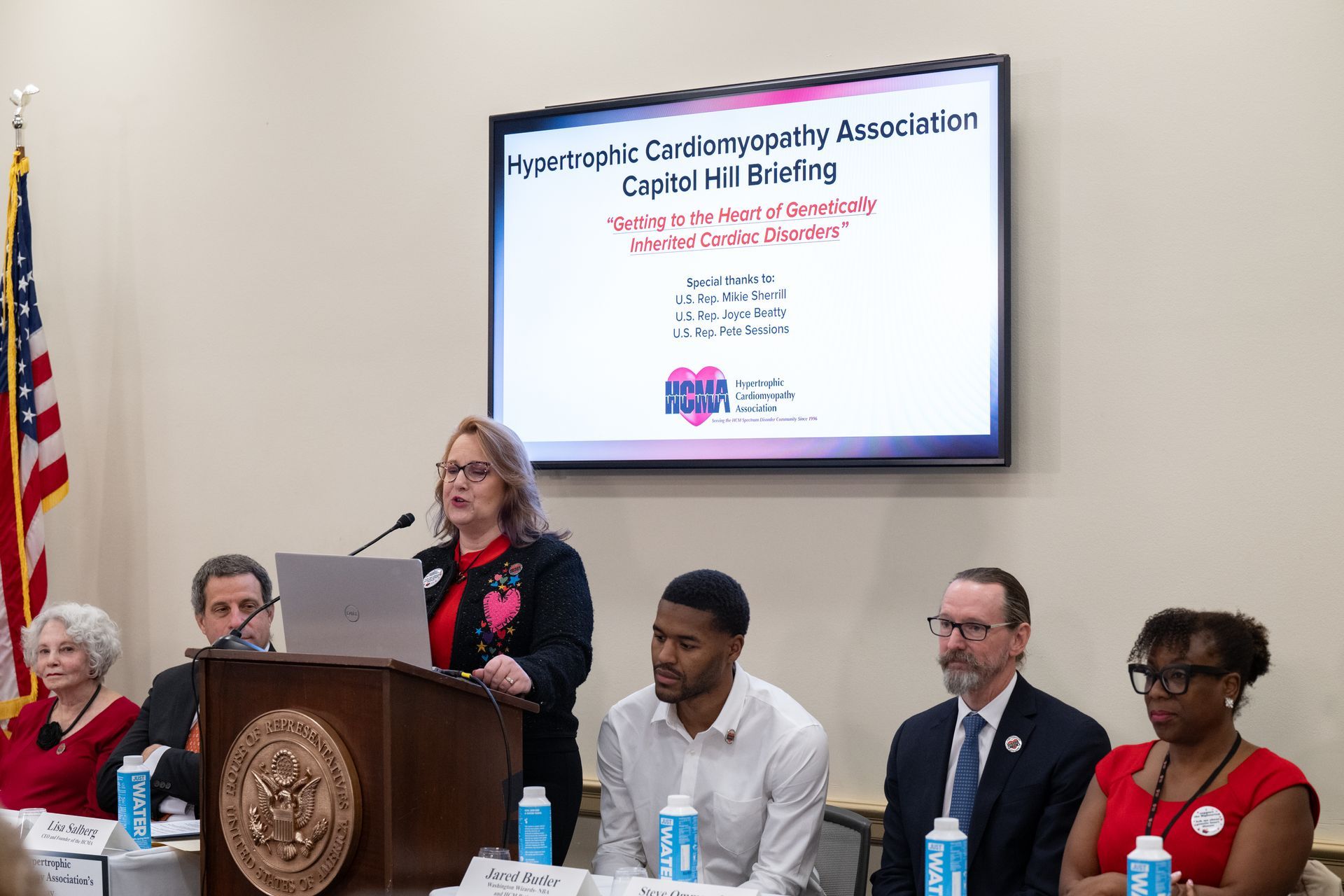Friedreich's Ataxia
An energy crisis in the cells
What is Friedreich's Ataxia?
Friedreich's Ataxia (FA) is very rare. More than half of adults with FA have heart problems, often "HCM". FA also causes muscle weakness, speech problems, spinal issues, diabetes, hearing loss, and vision loss. The muscle weakness is significant in these patients.

Friedreich's Ataxia (FA) is a rare genetic condition. Ataxia is a loss of muscle coordination that affects balance, speech, and motor functions. Symptoms of FA start younger than those of other forms of ataxia. Because FA can cause heart muscle to become thick, it can look like hypertrophic cardiomyopathy (HCM). For this reason, it's considered one of the HCM spectrum disorders. Not all patients with FA have heart problems, but those that do have a shorter lifespan.
How is FA like HCM?
Left ventricular hypertrophy (LVH) is common in both FA cardiomyopathy and HCM. The thickening of the heart (hypertrophy) can be asymmetrical like HCM. It can also be concentric (thick all the way around the left ventricle). The thickening causes stiff heart muscle, congestive heart failure, and abnormal heart rhythms. In severe cases of FA cardiomyopathy, the heart wall may begin to thin. This is similar to end-stage HCM.
What causes FA?
FA is caused by a mutation in the FXN gene. This gene helps make a protein called frataxin. Frataxin is important to mitochondria, the energy-producing part of cells. Without enough energy, cells can be damaged, leading to health problems. This mutation is recessive, so a person needs two copies of the mutated gene to get FA, one from each parent. A person with just one mutated gene is a carrier and will not have FA.
Genetic Testing - Family Screening
When a child has FA, each parent must have one normal and one mutated FXN gene. The child diagnosed with this condition should have genetic testing to confirm the diagnosis.
Any children from this set of parents have a 25% chance of having FA and a 50% chance of being carriers. Siblings of an FA patient should have genetic testing to find out if they are affected. If a person diagnosed with FA has children, they will all be carriers of the gene mutation.
A genetic counselor can help FA gene carriers decide whether to have children. IVF may help screen out affected embryos.
When do symptoms of FA start?
FA symptoms usually start in childhood or the early teens and include progressive symptoms. These include loss of coordination, muscle weakness, neurological problems, and other systemic issues. If an FA patient has heart problems, they usually start between 5 and 15 years of age.
Cardiac Features of FA
Arrhythmias and cardiomyopathy are the most common heart problems seen in FA patients. The left ventricle usually becomes very thick and stiff. Sometimes, its walls thin and dilate.
How is the heart monitored with FA?
Cardiologist Exam
A cardiologist should examine any FA patient who has heart symptoms or abnormal heart tests. Evaluation by a cardiologist is recommended before starting to exercise. The FA patient should see a cardiologist before any major surgery.
EKG/ECG
An EKG should be done at diagnosis and at least annually. A holter monitor should be used if someone with FA has palpitations. Many people with FA have EKG abnormalities. These include nonspecific ST-T wave changes, ventricular hypertrophy, or right axis deviation. They may have a short PR interval or an interatrial block.
MRI/CMR
If a more in-depth look at the heart is needed, a cardiologist may order a cardiac MRI (CMR). This gives a more accurate measurement of the heart's thickness. It can also show any fibrosis (scarring) in the heart.
Echocardiogram
An echo should be done at diagnosis and at least annually. Early detection of heart problems allows them to be better managed. A small study of FA patients showed septal hypertrophy in 81%. Left ventricular free wall hypertrophy was seen in 61%. A reduction of left ventricular internal dimension was found in 57% of the cases. Asymmetric septal hypertrophy (ASH) and systolic anterior motion (SAM) of the mitral valve were also seen.
How does FA affect other parts of the body?
FA patients often have trouble with balance. They have poor coordination and weakness in the legs, arms, or hands. A speech disorder with thick or slurred speech is often the first symptom. A curvature of the spine and high arches in the feet may develop. They may not know where their feet or hands are in space (impaired position sense). Over time, these problems usually get worse.
It is common for FA patients to have diabetes.
In the later stages of the disease, some FA patients have hearing or vision loss or a change in their color vision. Another late-stage symptom is problems with bladder or bowel control (incontinence).
Sexual problems, including erectile dysfunction (ED), can be treated with medication. Because this medication affects the heart, it's important to see a cardiologist before using it.
Symptomatic and comfort care
There is no cure for FA at this time, although researchers are looking for better treatments. Most care helps to reduce symptoms, improve quality of life, and allow patients to live longer.
It Takes a Team
For many with FA, a team of specialists will be needed. Specialists may include doctors for the heart, eyes, hearing, bones, bladder, and diabetes. What specialists are needed depends on which parts of the body are affected.
Medication
There is only one FDA-approved medicine for treating FA. SKYCLARYS (omaveloxolone) is used in patients aged 16 or older. Speak with your neurologist to see if this treatment might be helpful for you.
Medicines for heart problems
ACE inhibitors are medications used to slow or prevent reduced ejection fraction (EF). An alternative to ACE inhibitors is ARBs. Beta-blockers should be considered in addition to an ACE or ARB if the heart rate is over 75 beats per minute. The role of beta-blockers in treating children with FA is not clear.
Spironolactone or eplerenone should be given to those with New York Heart Association (NYHA) class 3 or 4 heart failure symptoms. FA patients should avoid some calcium channel blockers (verapamil and diltiazem).
Medicines for abnormal heart rhythms
Digoxin may be given if atrial fibrillation (AFIB) is present. Medicines to prevent atrial arrhythmias are beta-blockers, sotalol, dofetilide, or amiodarone. Avoid medications that can cause more abnormal heart rhythms. These include quinidine, flecainide, propafenone, and disopyramide.
Blood thinners for AFIB should not be started if the LVEF is normal. Anticoagulation should be considered in AFIB if other risk factors are present. Anticoagulation is recommended in paroxysmal or permanent AFIB if the LVEF is reduced.
Beta-blockers (metoprolol, bisoprolol, or carvedilol) are medications used to prevent ventricular arrhythmias. Sotalol and amiodarone are second-line options if the arrhythmia continues despite beta-blocker use.
ICD, CRT-D for heart failure
Device therapy is used for FA patients with heart failure and reduced ejection fraction.
ICD or CRT-D implantation should be considered if the LVEF is under 35%. Also, if the patient has NYHA functional class 2 or 3 symptoms despite medications. Finally, if the patient is expected to survive with good functional status for more than 1 year.
Heart Transplant
A heart Transplant is an option for FA patients with severe heart failure that doesn't respond to other therapies.
Cardiac Care during surgery
Heart monitoring should happen during any major surgery. Surgery should ideally be done in a center with cardiac intensive care facilities.
Sleep Apnea/OSA
As FA progresses, obstructive sleep apnea (OSA) is common. It’s important to evaluate sleep-disordered breathing annually. Those with FA should be referred for a sleep study as soon as any signs of apnea are seen. Patients with sleep apnea should use a CPAP or BPAP machine to help them breathe at night.
Life with FA
Those with FA should strive for as healthy a lifestyle as possible to maintain the best quality of life. This means exercising when possible, eating a balanced diet, and reducing stress. Use mobility aids as needed to prevent falls.
Good social support can help patients maintain their mental health. Support may come from family, friends, doctors, or mental health professionals. Adaptive clothing that's easier to put on and take off can help those with FA stay independent. Non-slip flooring, handrails, voice-activated lights, and other modifications may make the home safer.
Exercise Therapy
Exercise therapy, including structured aerobic exercise and light weights, is recommended. Heavy weight training is not advised.
Citations:
The Heart in Friedreich Ataxia: Definition of Cardiomyopathy, Disease Severity, and Correlation With Neurological Symptoms. Circulation
2012, Feb, 125 (13).
Consensus Clinical Management Guidelines for Friedreich's Ataxia. 2022. https://frdaguidelines.org/
Cross-Sectional Analysis of Electrocardiograms in a Large Heterogeneous Cohort of Friedreich Ataxia Subjects. J Child Neurol. 2012 Jun 29;27(9):1187–1192.
Echocardiographic findings in Friedreich's ataxia. Can J Neurol Sci. 1976 Nov;3(4):329-32.

 Translate
Translate